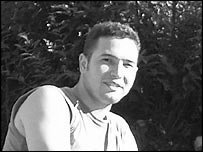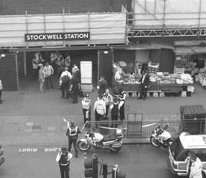In the aftermath of Jean Charles’ murder, Steve Kaczynski looks at Britain’s shoot-to-kill policy
On July 7 and July 21, bombs exploded in London. On July 22, a 27-year-old Brazilian electrician named Jean Charles de Menezes left his flat. He was followed by anti-terrorist police and in Stockwell underground station , he was shot a number of times – eight in all, according to what was stated later, and three more bullets missed him.

Initially, de Menezes was assumed to be involved in the July 21 explosions. However, before long the police admitted that he had nothing to do with the bombings.
The events are fairly well-known, if controversial in many places, but it is worth recapping briefly.
De Menezes was observed leaving a block of flats in Tulse Hill, South London. The flats were under surveillance because one or more of the suspects in the failed July 21 bombings were thought to be connected to them. According to what was claimed later, de Menezes was thought to match the description of Omar Hassain, a July 21 suspect.
De Menezes climbed on a bus and the surveillance continued. Officers of SO19, Scotland Yard’s specialist firearms branch, headed for Stockwell underground station.
Three SO19 officers, codenamed hospitably Hotel 1, Hotel 3 and Hotel 9, approached de Menezes and shot him a number of times, apparently while his body was in a standing position. The Brazilian had seven gunshot wounds to the head, and one to the shoulder.
According to witnesses, the shots – eleven in all – were fired at more or less regular intervals. Which does not suggest the police or whoever shot de Menezes were panicking and in fear of their lives, as might be expected of those in the vicinity of an alleged suicide bomber. A rather calm and clinical killing.
Attempts were made to explain police fears of a suicide bomber by saying de Menezes was wearing unseasonably bulky clothing which might have concealed an explosive vest. But footage of his dead body revealed that he was wearing a denim jacket – not an unusually heavy garment for the time of year.

That the killing of de Menezes was unhurried and casual, and not a split-second reaction by people in fear of their lives is the view of a number of people in a position to know. One, a security service source, told the Sunday Herald (August 21) that the shooting was not the way the police usually do things
, not even firearms-trained police, and posited an involvement by special forces.
Professor of Defence Studies Michael Clarke of King’s College, London expressed a similar view, and The Guardian stated on August 4 that the newly-formed Special Reconnaissance Regiment was involved in the operation. This unit is special forces
by any definition.
However, the official version is that SO19 officers shot de Menezes. It may be that special forces killed the Brazilian, but it is also possible that their shoot to kill
ethos has permeated police with firearms training, especially in the heightened circumstances following the July 7 bombing in London.Confirmation of this is provided by remarks made by Roy Ramm. Ramm, a former commander of special operations for the Metropolitan Police, said rules had been changed to permit shoot to kill
of a potential suicide bomber.
The death of de Menezes has caused a good deal of shock, and it may well be the first time somebody has been mown down like that on the streets of London for allegedly being a terrorist.
However, a little research suffices to show that gunning down the defenceless is not quite terra incognita for the British police.
As far back as 1983, Stephen Waldorf was shot and wounded in error by the Metropolitan Police. Fortunately for him, he lived to tell the tale.
In 1999, Harry Stanley was not so lucky. He was shot and killed while carrying a table leg, which apparently was mistaken for a firearm.
Nor is this kind of thing confined to London. In 1998, James Ashley was shot dead by Sussex Police on a drugs raid. Ashley was naked and unarmed.
And, of course, there are shootings connected with the north of Ireland. In 1988, it was decided that 11 RUC officers were not to be prosecuted over numerous shoot to kill
episodes in the province. This legal decision led to international criticism.
That same year, the Gibraltar shootings took place. A court decision found that the three Irish Republicans shot dead could have been arrested and not simply gunned down in the way they were.
All in all, Republicans, communists and socialists ought to show the least surprise of all that the British state carries out such summary executions.
In the aftermath of the de Menezes killing, criticism from his home country was parried by justified comments that death squads are not unknown in Brazil.
Indeed, such killings by police and state paramilitary forces are widespread in Latin America and many other parts of the world.
Turkey’s police, for example, think nothing of walking into cafes where there are terrorist suspects
and slaughtering everyone in a hail of bullets, on the kill everyone and let God sort it out
principle of law enforcement.
The killing of de Menezes – actually, the murder of de Menezes – is thus not such a new departure for the forces of bourgeois “law and order”. What it does show is that, when the chips are down and the time is out of joint, Britain’s authorities let their masks fall. They rest on naked violence and state terrorism as surely as the police patrolling the favelas of Rio de Janeiro, as certainly as special police teams prowling the shantytowns of Istanbul.
Our enemy is educating us as to his true nature. We should take full note of the lesson.
See Wikipedia for a valuable source of information on this subject.
